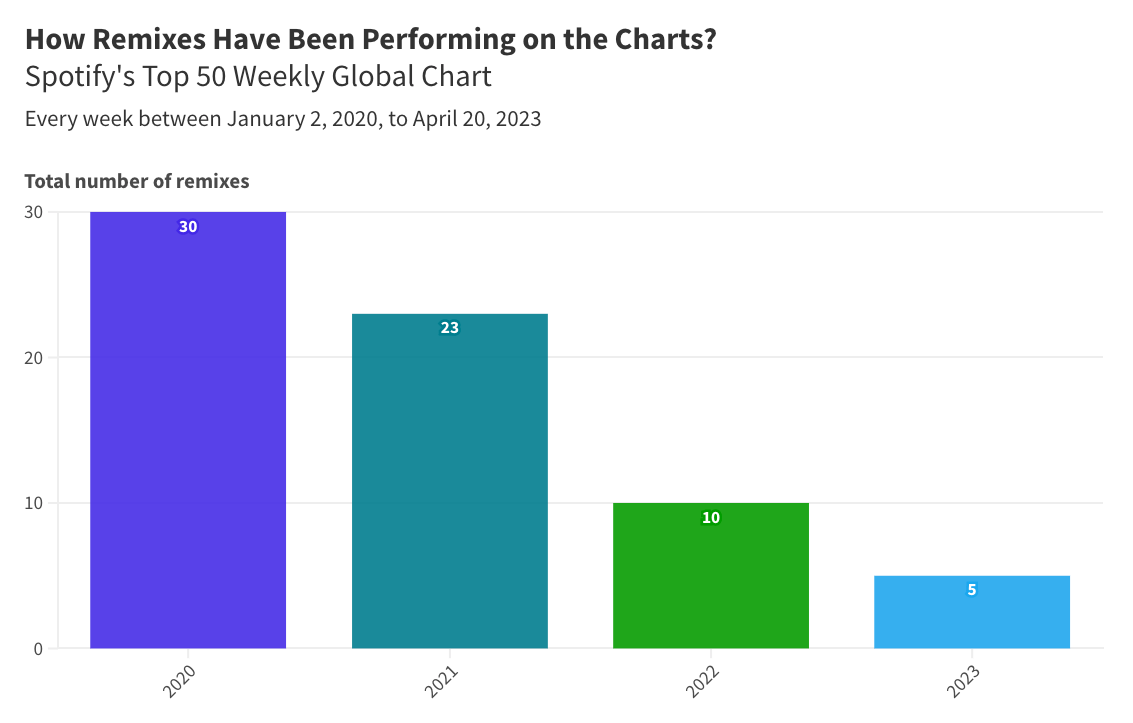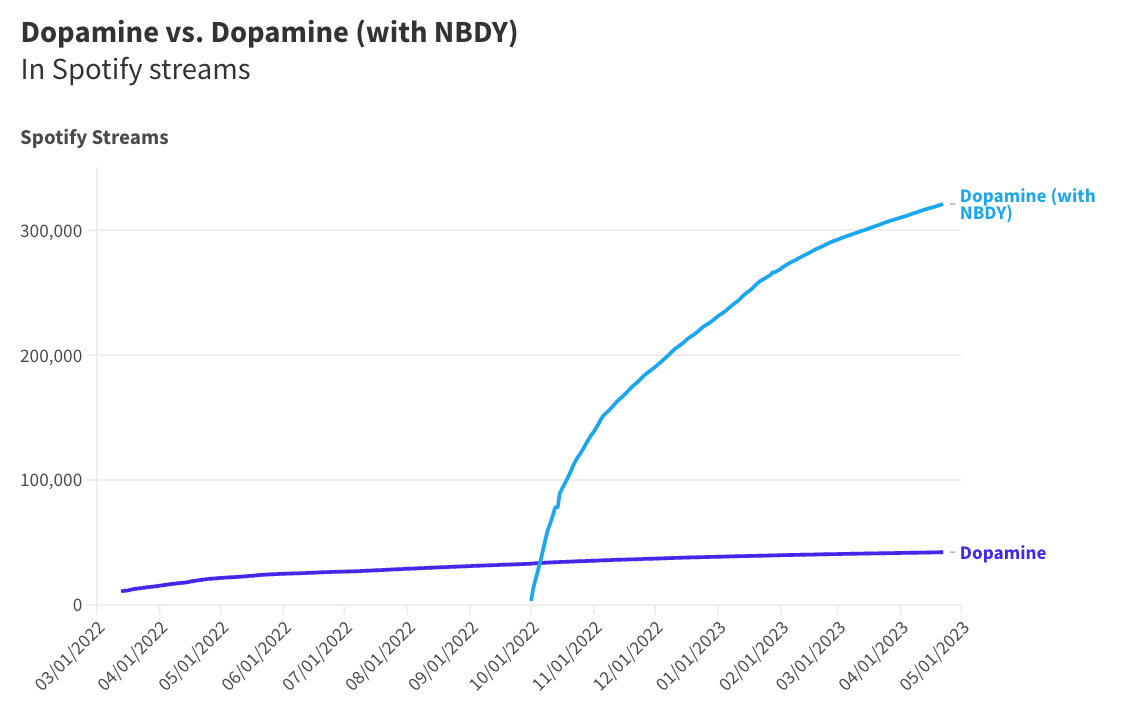Data reveals the real power of remixes from’Despacito’ to ‘Die For You’
Chartmetric analyzed popular remixes released since 2020 to examine their popularity and test their power in boosting a track’s performance, sometimes leading up to a No. 1 on the Billboard Hot 100.
by Jubran Haddad from Chartmetric Blog
Luis Fonsi and Daddy Yankee’s “Despacito” was already a huge hit in the Latin world before Justin Bieber collaborated on its remixed version. The Canadian artist was in Bogotá, Colombia, for a show when he heard the song at a nightclub. So, when his manager Scooter Braun told him about doing a remix, Bieber jumped right in. With a team quickly flying down to the capital to record, it only took four days from when he first heard the song to release its hit counterpart.
“He added an extra layer to the song. Sometimes you hear remixes and it’s different or you go to the original. He was very smart in that it started with his voice. Because your regular listener doesn’t know who Daddy Yankee and Luis Fonsi are. And that was very smart,” Luis Fonsi said about Justin Bieber’s verse on “Despacito” in the book “Decoding Despacito” by Leila Cobo.
Bieber’s Spanish singing boosted the track’s popularity, resulting in multiple number-one positions in various countries and increasing the visibility of Spanish-language pop music worldwide. Several remixes besides “Despacito” have reached the top spot on the Billboard Hot 100 chart since the 1990s, with some holding the position for weeks.

As we witness a surge in music manipulation, including the use of AI and sped-up and slowed-reverb versions of old and new tracks, it remains to be seen whether traditional remixes (which feature a guest artist or a remix producer) will maintain their cultural impact and longevity in the evolving musical landscape.
This article will test the trend of releasing traditional remixes as a post-release strategy in the current music industry. We will examine the present status of remixes, understand their implementation, and how they can benefit artists and even help land the No. 1 spot on the Billboard Hot 100 chart.
Defining a Remix
A remix is a modified version of a music recording that can be created by reorganizing its audio components and removing or adding certain elements. For most, remixes incorporate contributions from another artist or producer and are labeled as “Remix,” “Part II,” or using “featuring,” or “with.”
The Global Popularity of Remixes
We conducted a study by reviewing Spotify’s Top 50 Weekly Global Chart from the past three years and identifying remixes that made it to the chart for at least one week. Some popular tracks we discovered were Doja Cat’s “Say So” featuring Nicki Minaj, which gained popularity during the quarantine, and Ariana Grande’s recent guest feature on The Weeknd’s 2016 hit “Die For You.” In total, we found 68 tracks that fit the above-mentioned definition of a remix.
We discovered that, on average, remixes are released 155 days, or five months, after the original track. The year 2020 saw a significant number of remixes, with 30 appearing on the global chart for at least a week. However, this number decreased to 23 in 2021; only ten remixes made it to the global chart in 2022. However, with five tracks already making it to the global charts five months into 2023, this year may differ from the previous ones.

To understand the overall performance of remixes versus the original versions, we utilized the Chartmetric track score. This exclusive algorithm considers all related track performance metrics across seven popular platforms: Spotify, YouTube, TikTok, Airplay, Soundcloud, Pandora, and Shazam (with recent tracks receiving additional weighting). We restricted our analysis to remixes released up to 2022 and ended up with 63 tracks. Our findings revealed that remixes released between 2020-2022 had a lower track score than original tracks: on average, original tracks scored 434 while remixes scored 288.

There are a few potential reasons for this. First, listeners may have a stronger connection to the original version of a track that initially caught their attention. Additionally, marketing and promotion for remixes might not be as extensive as for the original, which could lead to lower popularity and engagement. Moreover, listeners may lose interest if remixes are frequently released or lack variation. Interested to see how your favorite tracks stand comparatively to their remix? You can explore tracks within our dataset and see how they stack across different metrics by selecting the track in the filter.

We also wanted to see the top remixes that have surpassed their original counterpart in the number of streams and rank them based on the streams’ gap sizes. We found out that Latin music is leading by example. Through collaboration with local artists, Latin music stars are gaining national and global recognition, blending audiences across various regions. For instance, Bad Bunny’s remix of “Volando,” Anuel AA, and Myke Towers’ collaboration on “Mon Amour” are breathing new life into lesser-known artists’ tracks. Latin artists do not have to sing in English or feature an English-speaking artist to attain global success. ¡Viva!

How Remixes Boost Indie Artists
On February 25, 2022, Benita, a Toronto-based artist, released the single “Dopamine” as part of her EP “SCARLET,” which was released on March 10, 2022. The song was included in Spotify editorial playlists such as Fresh Finds R&B and Mood Ring, but it didn’t receive as much attention as the other tracks on the EP. However, after NBDY added a verse to a remix of the song, “Dopamine” experienced a resurgence.

Within ten days of its release on September 26, 2022, the remix had more streams than the original version. It was featured on Spotify’s R&B Weekly, and Fresh Finds playlists, and as of today, it stands as Benita’s third most streamed song. This collaboration between Benita and NBDY exemplifies a successful remix that gave the track a second chance to shine.
But what happens when a track is already popular? Is it worth it to release a remix? It seems like releasing a remix can help break chart records. SZA’s “Kill Bill” managed to claim the top spot on the Hot 100 chart after spending eight nonconsecutive weeks at No. 2, all thanks to featuring Doja Cat on the remix. To provide a better understanding of that, let’s take a look at three popular songs by famous artists: “Creepin'” by Metro Boomin featuring The Weeknd and 21 Savage, “Die For You” by The Weeknd, and “Kill Bill” by SZA. These songs have competed with each other and other hits such as “Flowers” and “Boy’s a Liar Pt.2.” for the last few months. Additionally, remixed versions of these tracks have been released.
Let’s dive into each track and its remixes and see how they do on the charts using the Chartmetric track Score. It’s always exciting to see how music is performing in real-time.https://flo.uri.sh/visualisation/13562953/embed
Two remix versions of hit songs, “Creepin'” and “Kill Bill,” were released on March 17 and April 14, respectively. Neither of the remixes significantly impacted the original track’s popularity score; both original versions had the typical volatility of big hits, and are almost identical. While the “Kill Bill” remix performs better than the “Creepin'” remix, it still falls short of the original track.
In contrast, the remix version of “Die For You” is breaking records. On its opening day, it had the highest number of streams for a remix in Spotify’s history, with 8.9 million streams. While the original track maintained a consistent score, the remix peaked at 2608 on March 13 and has settled down to a score of 248 in the last two weeks. This impressive success is a testament to the strong friendship, previous collaborations, and mega-stardom of both The Weeknd and Grande.
How does that translate in the Billboard Hot 100? Billboard uses a complex equation to calculate a song’s rank on the Hot 100 chart. This equation takes into account all-genre U.S. streaming (including official audio and video), radio airplay, and sales data from all versions of the song. On the Hot 100, one version of the song (original or remix version) is listed, which is chosen based on the performance of the remix compared to the overall song consumption during the tracking week.

All three tracks received a boost on the chart. “Creepin'” climbed from No. 6 to No. 3, while both “Kill Bill” and “Die for You” reached No. 1. Although the “Kill Bill” remix did not perform as the “Die for You remix,” it contributed to SZA’s first Hot 100 No. 1, much like “Creepin'” jumping three spots after its remix. Despite minor musical differences, the remixes drove more traffic back to the original tracks and highlighted them. The remix of “Die for You” did so well that it replaced the original on the charts since it accounted for over half of the original track’s performance.
With that being said, releasing a remix can be the last effort to capitalize on a track’s potential when it’s already doing well and close to scoring No. 1. Lil Nas X’s “Old Town Road” crowned the chart for 19 weeks, thanks to the release of four remixes; the song’s original version remained on the charts, while the remixes worked behind the scenes to maintain popularity. But what sets tracks like “Old Town Road” and “Cheerleader” apart from others like “Kill Bill” and “Creepin’” is that they were originally introduced to the world as remixes. In contrast, the latter were released only after their original versions had global success.
Traditional remixes are still in
It seems that listeners may have a stronger connection to the original versions of a track. Yet, remixes are still capable of reviving a track, introducing artists to new audiences, and, scoring a No. 1. Even if, in the long run, remixes are less popular than the original, the popularity of a remix is not as important as its contribution to the original track’s ongoing legacy. Only time will tell which version listeners will prefer in the long run.
I’m making a decent compensation from home $62k/week , which was astonishing under a year prior I was jobless in a horrendous economy. I was honored with these guidelines and presently it’s my obligation to show kindness and share it with Everyone,
.
.
Here is I begun————————————➤ https://goodjobs2.pages.dev/